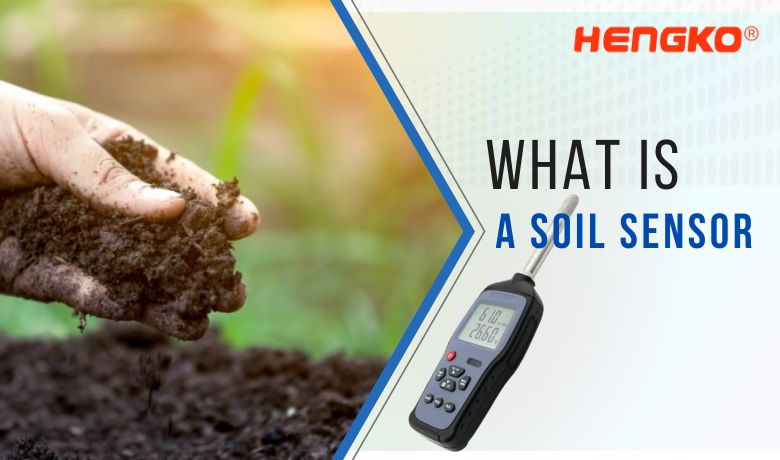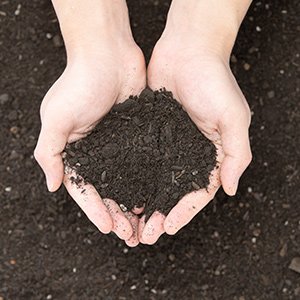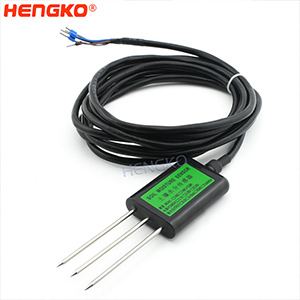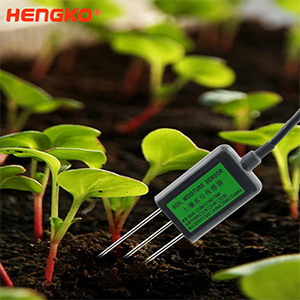
What is a Soil Sensor ?
Soil moisture refers to the moisture content of the soil. In farming, the inorganic elements in the soil cannot be directly obtained by the crops themselves, and the water in the soil acts as a solvent to dissolve these inorganic elements. Crops absorb soil moisture through their roots, obtaining nutrients and promoting growth. In the process of crop growth and development, due to different varieties, the requirements for soil temperature, water content and salinity are also different. Therefore, constant song sensors, such as temperature and humidity sensors and soil moisture sensors, are needed for the monitoring of these environmental factors. So Soil Sensor is a Sensor or Meter to measure the temperature and humidity of the soil.
Agricultural workers are familiar with soil moisture sensors, but there are many problems in selecting and using soil moisture sensors. Here are some common questions about soil moisture sensors.
The most commonly used soil moisture sensors in the market are TDR soil moisture sensor and FDR soil moisture sensor.
So What is Soil Moisture Sensor ?
A soil moisture sensor is a device used to measure the moisture content or water content in the soil. It provides information about the amount of water present in the soil, which is essential for efficient irrigation and plant health management.
The sensor typically consists of two metal probes that are inserted into the ground. When the soil is dry, it has high resistance to electrical current. As the soil moisture increases, the conductivity or electrical resistance decreases. The sensor measures the resistance between the two probes, and based on this measurement, it determines the soil moisture level.
Soil moisture sensors are used in various applications, including agriculture, horticulture, gardening, and environmental monitoring. They help farmers and gardeners optimize water usage by providing real-time data on soil moisture levels. This information enables them to make informed decisions about when and how much to irrigate, preventing overwatering or underwatering of plants.
Some soil moisture sensors are connected to automated irrigation systems, allowing for precise control of watering based on the real-time moisture readings. This automation helps conserve water and promotes healthier plant growth by ensuring plants receive the right amount of water at the right time.
Overall, So till now you have know soil moisture sensors play a crucial role in water management, helping to conserve resources, improve crop yields, and promote sustainable farming practices.
1. How a Soil Moisture Sensor Works ?
What is the Working principle Soil Moisture Sensor ?
A soil moisture sensor works by measuring the electrical conductivity or resistance of the soil, which is directly related to the moisture content. Here's a simplified explanation of how it works:
1. Probes: A typical soil moisture sensor consists of two metal probes, usually made of stainless steel or other corrosion-resistant material. These probes are inserted into the soil at a desired depth.
2. Electrical circuit: The sensor is connected to an electrical circuit that generates a small electric current between the probes.
3. Moisture content measurement: When the soil is dry, it has low conductivity and high resistance to electrical current. As the soil moisture increases, the conductivity or electrical resistance decreases.
4. Resistance measurement: The electrical circuit measures the resistance between the two probes. This resistance value is converted into a corresponding moisture level using calibration equations or lookup tables.
5. Output: The moisture level measurement is then displayed or transmitted to a device such as a microcontroller, data logger, or irrigation system controller. This allows users to monitor the soil moisture level in real-time.
It's important to note that soil moisture sensors may use different techniques or technologies to measure moisture content. For example, some sensors employ capacitance-based measurements or use frequency domain reflectometry (FDR) principles. However, the basic principle remains the same: measuring the electrical properties of the soil to determine its moisture content.
And Also You should Care the accuracy and reliability of soil moisture sensors can vary depending on factors such as sensor quality, soil composition, and calibration. Regular calibration and proper placement of the sensor probes at the desired root zone depth are essential for accurate readings.
FDR stands for frequency domain reflection, which uses the principle of electromagnetic pulse. The apparent dielectric constant (ε) of soil is measured according to the frequency of electromagnetic wave propagating in the medium, and the soil volume water content (θv) is obtained. The soil moisture sensor of HENGKO adopts the principle of FDR, and our product has good sealing performance, which can be directly buried in the soil for use, and is not corroded. High measurement accuracy, reliable performance, ensure normal operation, fast response, high data transmission efficiency.
TDR refers to the time domain reflectance, which is a common principle for rapid detection of soil moisture. The principle is that waveforms on mismatched transmission lines are reflected. The waveform at any point on the transmission line is the superposition of the original waveform and the reflected waveform. TDR principle equipment has a response time of about 10-20 seconds and is suitable for mobile measurements and spot monitoring.
2. Types Output of Soil Moisture Sensor?
Soil moisture sensors can provide different types of outputs depending on the specific sensor model and the application requirements. Here are the most common types of outputs from soil moisture sensors:
-
Analog output: Many soil moisture sensors provide an analog output signal, typically in the form of a voltage or current. The output value directly correlates to the moisture content in the soil. Users can connect the sensor to an analog input on a microcontroller or data logger, where they can read and process the analog signal to obtain the moisture level.
-
Digital output: Some soil moisture sensors have a digital output, such as a binary signal or a specific communication protocol. Digital sensors often use a threshold-based approach, where they provide a digital HIGH or LOW signal to indicate if the soil moisture level is above or below a certain threshold. This type of output is commonly used in automated systems or for simple moisture detection applications.
-
Wireless output: Certain soil moisture sensors are equipped with wireless communication capabilities, allowing them to transmit the moisture data wirelessly to a receiver or a central monitoring system. This wireless output can be in the form of Bluetooth, Wi-Fi, Zigbee, LoRa, or other wireless protocols, enabling remote monitoring and control of soil moisture levels.
-
Data logging output: Some advanced soil moisture sensors are designed with built-in data logging capabilities. These sensors can store the moisture readings internally over time. Users can later retrieve the data from the sensor, either by connecting it directly to a computer or by using a memory card or USB drive. This output type is particularly useful for long-term monitoring and analysis of soil moisture trends.
-
Visual display: Certain soil moisture sensors have an integrated visual display, such as an LCD screen, that directly shows the moisture level readings. This type of output is convenient for immediate on-site analysis without the need for additional devices or connections.
-
Smartphone app integration: Some modern soil moisture sensors can integrate with smartphone applications. These sensors transmit the moisture data to a dedicated mobile app via Bluetooth or Wi-Fi. Users can then view, analyze, and manage the soil moisture levels conveniently on their smartphones.
It's important to note that the availability of these output types can vary depending on the specific sensor model and manufacturer. It's advisable to check the specifications and documentation provided by the sensor manufacturer to determine the available output options and compatibility with your desired application.
Some Types Output HENGKO used for Soil Moisture Sensor
Voltage type Current type RS485 type
Working voltage 7~24V 12~24V 7~24V
Working current 3~5mA 3~25mA 3~5mA
Output signal Output signal: 0~2V DC (0.4~2V DC can be customized) 0~20mA, (4~20mA can be customized) MODBUS-RTU protocol
HENGKO suggests that the following points should be paid attention to when installing soil moisture sensors:
1. Vertical insertion of the sensor: Insert the sensor 90 degrees vertically into the soil to be tested. Do not shake the sensor during insertion to avoid bending and damaging the sensor probe.
2. Horizontal insertion of multiple sensors: Insert the sensors into the soil to be tested in parallel. The method is applied to multilayer soil moisture detection. Do not shake the sensor during insertion to avoid bending the sensor probe and damaging the steel needle.
3. How to right Soil Moisture Sensor for your agriculture projects or farm ?
To choose the right soil moisture sensor for your agriculture projects or farm, you can consider the following steps:
-
Assess your requirements: Determine your specific needs and goals. Consider factors such as the size of your farm, the types of crops you cultivate, and the irrigation system you use. This evaluation will help you identify the key features and capabilities required in a soil moisture sensor.
-
Research available options: Explore different soil moisture sensor models and brands. Look for sensors that are suitable for agricultural applications and offer accurate and reliable measurements. Consider factors such as sensor accuracy, measurement range, durability, ease of installation, and compatibility with your existing equipment or systems.
-
Understand sensor technology: Learn about the different technologies used in soil moisture sensors, such as resistance-based, capacitance-based, or frequency domain reflectometry (FDR). Each technology has its advantages and considerations, so choose the one that best aligns with your needs, soil type, and environmental conditions.
-
Consider soil conditions: Assess the characteristics of your soil, such as its texture, composition, and depth. Some sensors may perform better with certain soil types or depths. Ensure the sensor you choose is suitable for your specific soil conditions.
-
Calibration and accuracy: Consider the calibration process and accuracy of the sensor. Calibration ensures that the sensor readings are accurate and reliable. Check if the sensor requires regular calibration and if the manufacturer provides clear guidelines for the calibration procedure.
-
Integration and compatibility: Determine how the sensor will integrate with your existing systems or equipment. Consider the output type (analog, digital, wireless) and check if it is compatible with your data logging or irrigation systems. If you require remote monitoring, ensure that the sensor supports the necessary communication protocols.
-
Cost and budget: Consider your budgetary constraints and compare the costs of different sensors. Keep in mind that higher-quality sensors may provide better accuracy and durability, leading to long-term cost savings.
-
Reviews and recommendations: Read customer reviews, seek recommendations from fellow farmers or agricultural experts, and gather feedback on the performance and reliability of the soil moisture sensors you are considering. Real-world experiences can provide valuable insights.
-
Consult with experts: If needed, consult with agricultural experts, extension services, or local agriculture agencies to seek guidance and recommendations based on your specific farming practices and region.
By following these steps, you can make an informed decision and select a soil moisture sensor that meets your agriculture project or farm requirements, helping you optimize water usage, improve crop yields, and promote sustainable farming practices.
It is best to choose soft soil for insertion measurement. If you feel that there is hard lump or foreign matter in the tested soil, please re-select the position of the tested soil.
4. When the soil sensor is stored, wipe the three stainless steel needles with dry paper towels, cover them with foam, and store them in a dry environment of 0-60℃.
Our soil moisture sensor installation process is very simple, no need to hire a professional installation, save your labor costs. The products are suitable for water-saving agricultural irrigation, greenhouse, flowers and vegetables, grassland and pasture, soil speed measurement, plant cultivation, scientific experiment, underground oil, gas pipeline and other pipeline corrosion monitoring and other fields. In general, the cost of sensor installation depends on the area of the measurement site and the function achieved. Do you need to determine how many soil moisture sensors you need to install at the measurement site? How many sensors match a data collector? How long is the cable between the sensors? Do you need additional controllers to implement some automatic control functions? After understanding these problems, you can choose according to your needs or let HENGKO engineering team choose the right products and services for you.
FAQs
1. What is the purpose of a soil moisture sensor?
Answer: The purpose of a soil moisture sensor is to measure the moisture content in the soil. It provides information about the water availability in the soil, which is crucial for efficient irrigation management, preventing overwatering or underwatering, and promoting healthy plant growth.
2. How does a soil moisture sensor work?
Answer: Soil moisture sensors work by measuring the electrical conductivity or resistance of the soil. Typically, they consist of two metal probes inserted into the soil. The resistance between the probes changes with varying moisture levels. By measuring this resistance, the sensor determines the moisture content in the soil.
3. What features should I look for in a soil moisture sensor?
Answer: When choosing a soil moisture sensor, consider features such as accuracy, measurement range, durability, ease of installation, compatibility with irrigation systems or data loggers, and the type of output (analog, digital, wireless). Additionally, calibration requirements, sensor technology, and compatibility with different soil types should be taken into account.
4. How do I install a soil moisture sensor?
Answer: Installation procedures may vary depending on the sensor model. Generally, soil moisture sensors are inserted into the ground at the desired depth, ensuring good contact between the probes and the soil. It's essential to follow the manufacturer's guidelines for installation depth and placement to obtain accurate readings.
5. What are the applications of soil moisture sensors?
Answer: Soil moisture sensors have various applications, including agriculture, horticulture, landscaping, environmental monitoring, and research. They are used for irrigation management, precision farming, drought monitoring, optimizing water usage, and ensuring healthy plant growth. They are also employed in soil science studies, weather stations, and smart irrigation systems.
6. How often should I calibrate my soil moisture sensor?
Answer: Calibration frequency depends on the sensor type, manufacturer recommendations, and the level of accuracy required for your application. Some sensors may need calibration every growing season, while others may require more frequent or periodic calibration checks. Regular calibration is crucial to maintain accurate readings and ensure optimal performance.
7. Can soil moisture sensors be used in different soil types?
Answer: Yes, soil moisture sensors can be used in various soil types, including sandy, loamy, or clay soils. However, different sensors may have varying performance characteristics in different soil types. It's important to choose a sensor that is suitable for the specific soil type present in your application area.
8. Can soil moisture sensors be used for automated irrigation systems?
Answer: Yes, many soil moisture sensors can be integrated with automated irrigation systems. By connecting the sensor to the irrigation controller, it provides real-time soil moisture data. This data can be used to trigger irrigation cycles based on pre-set thresholds, ensuring efficient water management and reducing manual intervention.
9. Can soil moisture sensors be used in soilless growing systems?
Answer: Yes, soil moisture sensors can be used in soilless growing systems, such as hydroponics or aeroponics. In such systems, the sensors are placed in the growing media or substrate used to support plant roots. They provide essential moisture information for maintaining proper nutrient delivery and hydration levels in the root zone.
10. Are there any maintenance requirements for soil moisture sensors?
Answer: Maintenance requirements may vary among sensor models. Generally, it's recommended to periodically clean the sensor probes to remove any soil residue that may affect readings. Additionally, following manufacturer guidelines for storage, handling, and sensor maintenance is important to ensure long-term performance and accuracy.
For inquiries or to learn more about HENGKO's soil moisture sensors, contact us via email at ka@hengko.com.
We're here to assist you in finding the perfect solution for your agricultural projects. Don't hesitate to reach out to us!
Post time: Mar-15-2022








